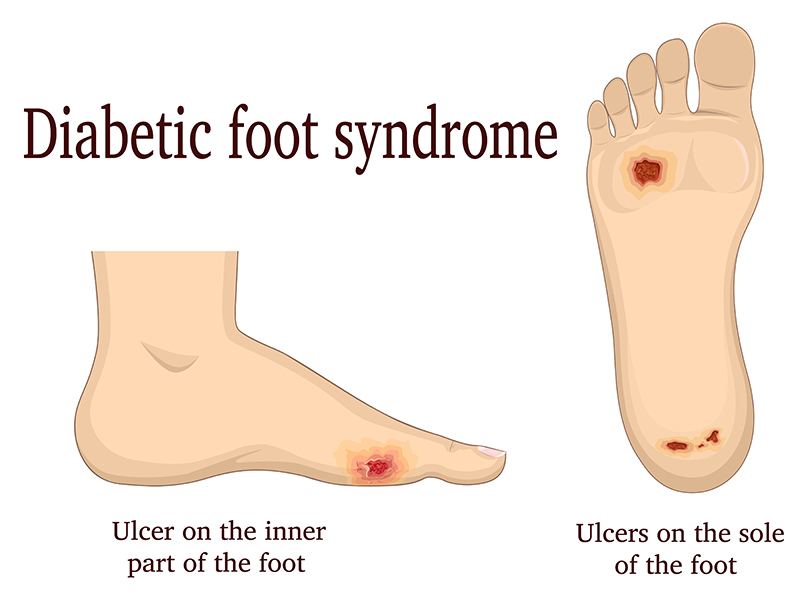Top 5 Foot Care Tips For Diabetics

The disease of diabetes now affects more than 100 million American adults, according to the Centers for Disease Control and Prevention. Diabetes damages blood vessels in all parts of the body, especially the feet. The legs and feet may develop slow blood flow, which causes neuropathy, or nerve damage. Once a diabetic patient develops neuropathy, it is important that the feet are well taken care of. Otherwise, the lower limbs may have to be amputated. This only happens in drastic cases, but it shows how seriously diabetic foot care should be taken.
Some notable and dangerous complications of this common disease are foot conditions like sores, ulcers, and infections, which can lead to a loss of a toe or worse. Therefore, with the prevalence of the disease and the fact that foot infections, when allowed to get out-of-hand, can be problematic and even life-threatening, it is vital that anyone who has diabetes take especially good care of their feet.
To help you accomplish this, the professionals at Red Mountain Footcare have compiled this following list of tips to help you ensure your feet are as healthy as possible.
5 Diabetic Foot Care Tips
- Trim Your Toenails Regularly: Make sure to trim your toenails regularly to ensure they don’t cut your foot when one grows too long or rough. Trim them after you have washed them so they are softer and easier to cut. You can use an emery board to smooth out the edges of your nails. Be sure not to cut your nails too short in the corners or too deeply around their cuticles, as this can lead to infection. Toenails may need to be taken care of by a podiatrist.
- Check Feet Daily: Diabetes tends to mess with a person’s nerve endings. This can result in numb feet. If you can relate to this and understand what it means to be unable to feel your feet, you must be extra careful. You can have a cut or blister on your foot and not even be aware because you can’t feel them. Some people have even been known to have a needle within their foot without knowing it was there. Therefore, check your feet periodically for any signs of infection, the presence of blisters or cuts.
- Wear Diabetic Socks: Today, there are a variety of products available designed to protect a diabetics’ feet from infection and cuts. Wear diabetic socks, especially at night to keep your feet from getting cold. Another common problem with diabetes is poor circulation, which can lead to cold limbs. Well-designed diabetic socks aren’t too tight but are designed to promote blood circulation and help you maintain a good temperature in your limbs. Try to avoid wearing colored socks to prevent infections that may occur from the dye.
- Invest in a Good Pair of Diabetic Shoes & Wear Them Even in The House: Shoes specifically designed for diabetics leave more room for the toes to move. They also reduce the pressure on the foot and prevent sores from developing. Diabetic shoes are also breathable, allowing air to move in and out of the shoe. The idea is to protect the foot from external threats of all kinds, while keeping them comfortable, even within the house.
- Keep Your Skin Well Moisturized: In general, diabetics have drier skin, which can lead to the skin becoming cracked or worse. This is because diabetics sweat less in their feet region than those without the disease. Therefore, to prevent the common problems associated with dry feet, diabetics should keep their feet well moisturized by applying location or specialty moisturizer to the feet once or even twice daily.
BONUS TIP – As a general rule, it’s very important to always wash and dry the feet thoroughly, especially in between the toes, if you’re a diabetic.
Check for Foot Ulcers and Gangrene
You never want to wait until a wound becomes too severe to treat. If left untreated, gangrene may develop. Gangrene is a serious infection that can lead to sepsis or amputation.
It is also important for diabetics to be on the lookout for ulcers. Ulcers are sores that develop from tissue loss on the skin. They can be quite painful and require intensive treatment. Early treatment and everyday inspection are imperative to staying healthy.
If you are ever concerned about something, contact your health care professional.
Talk to a Professional
A diabetic’s physician should always monitor their blood levels to test how well blood sugars are being maintained. In addition to giving advice about everyday eating habits and foot care, a physician may prescribe medicine to help with the diabetic patient’s neuropathy. It is also advised to see a podiatrist if experiencing any feet conditions.
